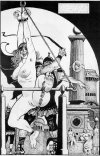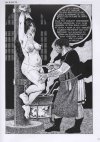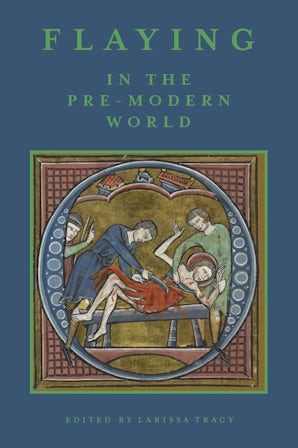Last edited by a moderator:
-
Sign up or login, and you'll have full access to opportunities of forum.
You are using an out of date browser. It may not display this or other websites correctly.
You should upgrade or use an alternative browser.
You should upgrade or use an alternative browser.
Public Executions In The Arena

Another arena execution involving a bull. This terracotta image is from North Africa.
It's a variant of the Dirce myth, with the female victim riding the bull with her hands tied behind her, instead of being dragged by the bull. A leaping leopard is attacking her.
The image might even have been made as a souvenir of an unusual and interesting execution, for a Roman visitor to the arena to take back home to his villa.

It's a variant of the Dirce myth, with the female victim riding the bull with her hands tied behind her, instead of being dragged by the bull. A leaping leopard is attacking her.
The image might even have been made as a souvenir of an unusual and interesting execution, for a Roman visitor to the arena to take back home to his villa.

Last edited by a moderator:
Were the male and female performers who appeared in the Roman arena clothed or naked? The scholarly verdict is......naked.
The bodies of the men and women who appeared in the Roman arena were typically naked, either nearly or completely so : 'The males might be naked or clad only in a loin cloth, the women at times in light tunics or in a skirt and brassiere, at other times in the nude.'
The practice of stripping the condemned criminal is codified in the Digest of Justinian, though it originated much earlier according to the Digest's testimony: 'Someone should not be stripped when he is put in prison but only after his condemnation, as the deified Hadrian wrote in a rescript.'
The stripping of the criminal signified his or her inferior social status: the naked body of the condemned stood in contrast with the impressively armed and costumed body of the voluntary gladiator and the toga and tunic-wearing audience.
The naked exposure of women's bodies would have been particularly degrading. Peter Brown writes of fourth-century Antioch: 'Nudity and sexual shame were questions of social status. The lower classes were not expected to be capable of protecting their womenfolk from exposure. The seclusion of one's womenfolk assumed power and wealth. The sexual vulnerability of poor girls was simply part of their general passivity to the powerful.'
The degradation of naked women in the arena was sometimes so shocking that it backfired, at least according to Christian accounts, evoking pity in the crowd, who were said to have asked that women martyrs be clothed.
From Execution and Invention by Beth A. Berkovitz
The bodies of the men and women who appeared in the Roman arena were typically naked, either nearly or completely so : 'The males might be naked or clad only in a loin cloth, the women at times in light tunics or in a skirt and brassiere, at other times in the nude.'
The practice of stripping the condemned criminal is codified in the Digest of Justinian, though it originated much earlier according to the Digest's testimony: 'Someone should not be stripped when he is put in prison but only after his condemnation, as the deified Hadrian wrote in a rescript.'
The stripping of the criminal signified his or her inferior social status: the naked body of the condemned stood in contrast with the impressively armed and costumed body of the voluntary gladiator and the toga and tunic-wearing audience.
The naked exposure of women's bodies would have been particularly degrading. Peter Brown writes of fourth-century Antioch: 'Nudity and sexual shame were questions of social status. The lower classes were not expected to be capable of protecting their womenfolk from exposure. The seclusion of one's womenfolk assumed power and wealth. The sexual vulnerability of poor girls was simply part of their general passivity to the powerful.'
The degradation of naked women in the arena was sometimes so shocking that it backfired, at least according to Christian accounts, evoking pity in the crowd, who were said to have asked that women martyrs be clothed.
From Execution and Invention by Beth A. Berkovitz
While the degradation of the lower classes was part of Roman society, as noted, it was part of a certain passivity of the ruling classes. Lower classes were simply not that honourable - that was sort of 'just the way things are'. That said, Roman society was somewhat "prudish" - upper class families would protect and seclude their women to protect their modesty and honour, and public nakedness was frowned on. Similarly, sexual excess, lewd behaviour, etc. were disparaged, and honourable men were supposed to be able to control their sexual urges. On the one hand, this might explain why punishments were degrading - a condemned criminal was shown to be completely without any human dignity, separated and cut off from decent people. It also explains why Romans, perhaps a bit disturbed by the orgies and sexual license taken by certain emperors, embraced a "moral" religion like Christianity.The degradation of naked women in the arena was sometimes so shocking that it backfired, at least according to Christian accounts, evoking pity in the crowd, who were said to have asked that women martyrs be clothed.
willowfall
Senator
While the degradation of the lower classes was part of Roman society, as noted, it was part of a certain passivity of the ruling classes. Lower classes were simply not that honourable - that was sort of 'just the way things are'. That said, Roman society was somewhat "prudish" - upper class families would protect and seclude their women to protect their modesty and honour, and public nakedness was frowned on. Similarly, sexual excess, lewd behaviour, etc. were disparaged, and honourable men were supposed to be able to control their sexual urges. On the one hand, this might explain why punishments were degrading - a condemned criminal was shown to be completely without any human dignity, separated and cut off from decent people. It also explains why Romans, perhaps a bit disturbed by the orgies and sexual license taken by certain emperors, embraced a "moral" religion like Christianity.
Well yes and no. It depended a lot of the time period.
For example once silk started to become available and fashionable in upper Roman society you do find quotations from authors complaining about how revealing the fabric was. I don't remember the exact wording of the quote from one author but it went something like this "now everyone knows her body as well as her husband does."
And certainly a number of the mosaics from Pompeian Villa's (the homes of the rich) go over the line of modern pornographic. Orgies are certainly well documented in Roman culture.
That being said there is the example in the Republic of a Roman army surrendered to the Sammites (and one to the Celts) of being forced to walk naked 'underneath the yoke' before having their cloths returned to them. Implying that they were lower than the Sammites and owned the Sammites for allowing them cloths.
As to Rome "embracing" Christianity that was something that happened over hundred's of years and even after Constantine (who converted on his death bed) there was at least one pagan Emperor. Very much like the common folk of England referring to the Anglican Church during Elizabeth's reign as the "New Religion" (and having several Catholic Kings after her) just because the upper echelon cynically embraces something to get ahead doesn't mean it permeated the society.
All in all though forced nudity has been used as a humiliation tactic throughout history. Maybe 'force" and 'nudity' is the key here.
kisses
willowall
GeorgeL
Senator
Woooow!!!... are there other pics from this series???Cruxified and tortured for a long time death is not going to come immediately
frawings by Templeton
View attachment 1079811View attachment 1079812View attachment 1079813View attachment 1079814View attachment 1079819
nsur1
Governor
I have found these images in a collection of random Georges Pichard drawings -- they appear to come from a 1966 publication of "La Vie des Saintes" which I have not previously seen. Execution scenes of female martyr saints in the arena and other Roman settings. I see it listed in this bio of Pichard, but not in his Wikipedia entry.





Two more images that fit the theme of Roman executions but aren't from that publication -- not sure where they fit into Pichard's output.







Two more images that fit the theme of Roman executions but aren't from that publication -- not sure where they fit into Pichard's output.


Last edited:
I love Prichard but haven’t seen any of these before! Lovely, thank you, I love his penchant for using fuller bodied women, refreshing to not just see underfed waifs…I have found these images in a collection of random Georges Pichard drawings -- they appear to come from a 1966 publication of "La Vie des Saintes" which I have not previously seen. Execution scenes of female saints in the arena and other Roman settings. I see it listed in this bio of Pichard, but not in his Wikipedia entry.
View attachment 1082193View attachment 1082191View attachment 1082190View attachment 1082192View attachment 1082189
Two more images that fit the theme of Roman executions but aren't from that publication -- not sure where they fit into Pichard's output.
View attachment 1082188View attachment 1082187
GustaavX
Onlooker
Seems like such a shame for the one who misses out? What happens to the devastated loser? Is she put into the next round? Tortured? Sold? Don’t tell me she has to suffer the indignity of being set free, how awful for her?Try to catch the Christian slave girls to crucify them. They play along, a kind of musical chairs, there is 1 cross less than girls running through the arena.
GustaavX
Onlooker
No, she only avoids the cross, there will surely be a painful and humiliating death for her. What would it be?Seems like such a shame for the one who misses out? What happens to the devastated loser? Is she put into the next round? Tortured? Sold? Don’t tell me she has to suffer the indignity of being set free, how awful for her?
M
montycrusto
Guest
The whole comic is hereWoooow!!!... are there other pics from this series???
Fansadox 154 - Templeton - Rome | 8muses - Sex and Porn Comics
A huge collection of free porn comics for adults. Read 101-200/Fansadox 154 - Templeton - Rome online for free at 8muses.com
chimaera
Magistrate
The Romans had a view of sex that was very different from that of the Abrahamic religions. It was viewed as a good thing, and something to be celebrated, BUT only in the correct circumstances, typically between a married couple (divorce was common in the upper classes so that did not mean a single partner for life) or between a man and a prostitute. In the latter seas there were 'normal' prostitutes. and those associated with temples, where it was a religious experience of sorts (but often very expensive as a result). In those circumstances, murals and mosaics showing sex were commonplace, and it was celebrated in some household gods. Orgies with groups of married couples were sometime acceptable, at other times not. Nudity was fine amongst the same sex, such as in baths, but in most cases not with opposite sexes unless for sex as above. As has been said, nudity and sex outside this was the ultimate humiliation, so nudity in executions was commonplace at some times at least. Public rape would not have been acceptable to a general audience so was very rare, but was the ultimate humiliation and probably only carried out within the army, such as when Boudicca's daughters were raped in front of her.Well yes and no. It depended a lot of the time period.
For example once silk started to become available and fashionable in upper Roman society you do find quotations from authors complaining about how revealing the fabric was. I don't remember the exact wording of the quote from one author but it went something like this "now everyone knows her body as well as her husband does."
And certainly a number of the mosaics from Pompeian Villa's (the homes of the rich) go over the line of modern pornographic. Orgies are certainly well documented in Roman culture.
That being said there is the example in the Republic of a Roman army surrendered to the Sammites (and one to the Celts) of being forced to walk naked 'underneath the yoke' before having their cloths returned to them. Implying that they were lower than the Sammites and owned the Sammites for allowing them cloths.
As to Rome "embracing" Christianity that was something that happened over hundred's of years and even after Constantine (who converted on his death bed) there was at least one pagan Emperor. Very much like the common folk of England referring to the Anglican Church during Elizabeth's reign as the "New Religion" (and having several Catholic Kings after her) just because the upper echelon cynically embraces something to get ahead doesn't mean it permeated the society.
All in all though forced nudity has been used as a humiliation tactic throughout history. Maybe 'force" and 'nudity' is the key here.
kisses
willowall
Whilst we think of Romans as debauched, this was restricted to a small number of very famous cases, largely of early imperial emperors. This behaviour (possible partly due to brain damage due to drinking wine sweetened with lead) probably aided the call for the assassinations of the worst offenders. Of course sexual excess is common in very powerful people, and was often not popular with the population (for example, Britain's George IV had a special stool made with a notch in the front and a 'bed' underneath, so he could have one woman giving him a blowjob with another on her back underneath sucking his balls.)
willowfall
Senator
The Romans had a view of sex that was very different from that of the Abrahamic religions. It was viewed as a good thing, and something to be celebrated, BUT only in the correct circumstances, typically between a married couple (divorce was common in the upper classes so that did not mean a single partner for life) or between a man and a prostitute. In the latter seas there were 'normal' prostitutes. and those associated with temples, where it was a religious experience of sorts (but often very expensive as a result). In those circumstances, murals and mosaics showing sex were commonplace, and it was celebrated in some household gods. Orgies with groups of married couples were sometime acceptable, at other times not. Nudity was fine amongst the same sex, such as in baths, but in most cases not with opposite sexes unless for sex as above. As has been said, nudity and sex outside this was the ultimate humiliation, so nudity in executions was commonplace at some times at least. Public rape would not have been acceptable to a general audience so was very rare, but was the ultimate humiliation and probably only carried out within the army, such as when Boudicca's daughters were raped in front of her.
Whilst we think of Romans as debauched, this was restricted to a small number of very famous cases, largely of early imperial emperors. This behaviour (possible partly due to brain damage due to drinking wine sweetened with lead) probably aided the call for the assassinations of the worst offenders. Of course sexual excess is common in very powerful people, and was often not popular with the population (for example, Britain's George IV had a special stool made with a notch in the front and a 'bed' underneath, so he could have one woman giving him a blowjob with another on her back underneath sucking his balls.)
Well again yes and no. Remember "Rome" as an important local political power, thru the republic and then the empire was an almost 800 year long enterprise in the West and longer in the east. It ran thru many moral iterations. We can point to any behavior we'd like (based on our concepts) and say 'this was it'. That just isn't so. You find a massive amount of 'immoral' behavior by their own standards occurring (example Roman writers decrying the use of silk as a fabric among upper class women) at all times during the extended existence. You also find posthumous destroying (or enhancing) of the reputations depending on who was in power (as a later example Shakespeare was something of a Tudor shill).
Human sexual excesses are not limited to a particular economic\political strata (although those who are out of power often portray this is so in order to gain power thru class warfare) but opportunity. Admittedly the wealthy and powerful have more opportunity than the poor do. And many times 'disapproval' is based on envy. How often in history have we seen one group shoved out of power because they did "X" and a few years later the group that shoved them out of power is also doing "X"?
Personally I don't think of any culture or time period as debauched because I don't judge them by the standards of MY TIME but I try to look at them by the standards of their time.
And I would say your statement of "Public rape would not have been acceptable" is incorrect based on the fact that every conquered population from the earliest dawn of written history thru about 1700 or so (and that is strictly a European cut off date) expected to be "sacked" which included rape. And when they had their turn on top they did exactly the same thing.
And I am also not sure how you can discount all of the sexually based art that comes out of the classical period too when you state "Nudity was fine amongst the same sex, such as in baths, but in most cases not with opposite sexes unless for sex as above." when virtually every significant public place, temple, wealthy house had nude art within them.
ENFORCED public nudity was a humiliation because it signified someone had power over you. I'm not sure you can apply that to nudity in general (Hell there was an early American President who used to go skinny dipping in the Potomac).
Societies have a perception they wish to create in order to make themselves look better (witness Victorian England) and their enemies have a perception they wish to create in order to make they other side look bad. When I look back at extant writings from any time period, existing physical evidence and myth\rumor I have come to believe humans have evolved very little since homosapien appeared on this planet as far as our BIOS is concerned.
What changes is OUR perceptions of what we see based on who we are right now this minute.
As an example for a long time it was considered Roman propaganda that the Carthagians sacrificed child. In the last 50 years or so a lot of archeological evidence has emerged that maybe the Roman's weren't so far from the truth after all. Egyptology was stalled as long as Egyptologist took the Old Testament as a literal document, it only got rolling when they tossed the Bible over their shoulders and started to look at the evidence in front of them.
Both of those "truths" (A word I hate) were based on what we wanted to believe at the time not what we saw in front of us.
Over it's existence Rome was many different things, as America has been, neither you nor I am absolutely right or wrong. We are both both depending on which time period we pick and which evidence we find most creditable.
kisses
willowfall
GeorgeL
Senator
Thanks!!The whole comic is here
Fansadox 154 - Templeton - Rome | 8muses - Sex and Porn Comics
A huge collection of free porn comics for adults. Read 101-200/Fansadox 154 - Templeton - Rome online for free at 8muses.comcomics.8muses.com
chimaera
Magistrate
OK, I was generalising a lot- 500 years of history spanning the Scottish mountains to the Sahara. I was really focussing on the early (high) Imperial period of Italy, where there are good written records from Rome and the archaeology of Pompeii. Concentrating only on the arena, some things were suitable entertainment for the masses, others not. There is no evidence for sexual violence in the arenas, although the nudity and violence no doubt had the same effect on the audience. We apparently have Nero to thank for the first female gladiators, and an upsurge of 'atypical' entertainment in general. But well before this, it was not unknown at funerals to have female slaves of the deceased fighting to the death for entertainment, but that was not public.Well again yes and no. Remember "Rome" as an important local political power, thru the republic and then the empire was an almost 800 year long enterprise in the West and longer in the east. It ran thru many moral iterations. We can point to any behavior we'd like (based on our concepts) and say 'this was it'. That just isn't so. You find a massive amount of 'immoral' behavior by their own standards occurring (example Roman writers decrying the use of silk as a fabric among upper class women) at all times during the extended existence. You also find posthumous destroying (or enhancing) of the reputations depending on who was in power (as a later example Shakespeare was something of a Tudor shill).
Human sexual excesses are not limited to a particular economic\political strata (although those who are out of power often portray this is so in order to gain power thru class warfare) but opportunity. Admittedly the wealthy and powerful have more opportunity than the poor do. And many times 'disapproval' is based on envy. How often in history have we seen one group shoved out of power because they did "X" and a few years later the group that shoved them out of power is also doing "X"?
Personally I don't think of any culture or time period as debauched because I don't judge them by the standards of MY TIME but I try to look at them by the standards of their time.
And I would say your statement of "Public rape would not have been acceptable" is incorrect based on the fact that every conquered population from the earliest dawn of written history thru about 1700 or so (and that is strictly a European cut off date) expected to be "sacked" which included rape. And when they had their turn on top they did exactly the same thing.
And I am also not sure how you can discount all of the sexually based art that comes out of the classical period too when you state "Nudity was fine amongst the same sex, such as in baths, but in most cases not with opposite sexes unless for sex as above." when virtually every significant public place, temple, wealthy house had nude art within them.
ENFORCED public nudity was a humiliation because it signified someone had power over you. I'm not sure you can apply that to nudity in general (Hell there was an early American President who used to go skinny dipping in the Potomac).
Societies have a perception they wish to create in order to make themselves look better (witness Victorian England) and their enemies have a perception they wish to create in order to make they other side look bad. When I look back at extant writings from any time period, existing physical evidence and myth\rumor I have come to believe humans have evolved very little since homosapien appeared on this planet as far as our BIOS is concerned.
What changes is OUR perceptions of what we see based on who we are right now this minute.
As an example for a long time it was considered Roman propaganda that the Carthagians sacrificed child. In the last 50 years or so a lot of archeological evidence has emerged that maybe the Roman's weren't so far from the truth after all. Egyptology was stalled as long as Egyptologist took the Old Testament as a literal document, it only got rolling when they tossed the Bible over their shoulders and started to look at the evidence in front of them.
Both of those "truths" (A word I hate) were based on what we wanted to believe at the time not what we saw in front of us.
Over it's existence Rome was many different things, as America has been, neither you nor I am absolutely right or wrong. We are both both depending on which time period we pick and which evidence we find most creditable.
kisses
willowfall
What went on on the frontiers or Empire as the army swept in, or within the villas of the nobility, are rather different. But even here there was often a pattern; for example when Corinth was sacked and all the inhabitants enslaved or killed and the city levelled, a temple on the hill of Acrocorinth was left untouched, and the temple priestesses/prostitutes were left to get on with their job (the Roman generals no doubt finding them a useful diversion).
Anyway, what have the Romans ever done for us? Other than the sex and violence of course. Pass me a bag of otter's noses.
nsur1
Governor
I think this one is from Pichard's "La vie des Saintes" as well -- the martyrdom of St. Julitta, executed in AD 304 by the Roman governor of Tarsus. Pichard shows her to be flayed, although Wikipedia says she was executed by having her sides "ripped apart with hooks", followed by beheading.I have found these images in a collection of random Georges Pichard drawings -- they appear to come from a 1966 publication of "La Vie des Saintes" which I have not previously seen. Execution scenes of female martyr saints in the arena and other Roman settings. I see it listed in this bio of Pichard, but not in his Wikipedia entry.
View attachment 1082193View attachment 1082191View attachment 1082190View attachment 1082192View attachment 1082189
Two more images that fit the theme of Roman executions but aren't from that publication -- not sure where they fit into Pichard's output.
View attachment 1082188View attachment 1082187

Yes, stretching the victim then tearing her taut flanks with hooks (women's breasts too) seems to have been pretty well standard practice, it's mentioned in so many early accounts of martyrdoms it's surely more than a sadistic fantasy. On the other hand, flaying was exceptional, though St Bartholomew was a well-known example. Needless to say, there's a learned treatise on the topic:I think this one is from Pichard's "La vie des Saintes" as well -- the martyrdom of St. Julitta, executed in AD 304 by the Roman governor of Tarsus. Pichard shows her to be flayed, although Wikipedia says she was executed by having her sides "ripped apart with hooks", followed by beheading.
View attachment 1109159

Flaying in the Pre-Modern World
Skin is the parchment upon which identity is written; class, race, ethnicity, and gender are all legible upon the human surface. Removing skin tears away ide...
I must admit the opening sentence of the blurb makes me wonder if it's a piss-take -
Skin is the parchment upon which identity is written; class, race, ethnicity, and gender are all legible upon the human surface. Removing skin tears away identity, and leaves a blank slate upon which law, punishment, sanctity, or monstrosity can be inscribed; whether as an act of penal brutality, as a comic device, or as a sign of spiritual sacrifice, it leaves a lasting impression about the qualities and nature of humanity.
Well, yes, being flayed alive would leave a lasting impression
 but the list of contents looks quite promising, maybe there's less pretentious academic waffle when you get into it.
but the list of contents looks quite promising, maybe there's less pretentious academic waffle when you get into it.

![Dirce[1].jpg Dirce[1].jpg](https://www.cruxforums.com/xf/data/attachments/1064/1064705-0a5169590dc77151654ce3d503439527.jpg)







